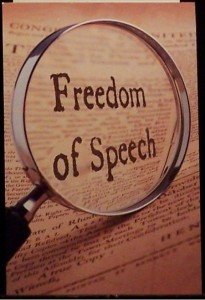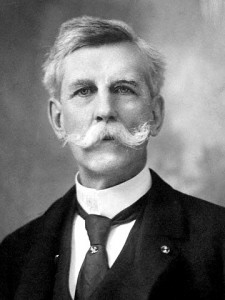Jun
16
Shouting “Fire!” and the First Amendment
What do a crowded theater and anti-war pamphleteering have in common? What do they have to do with your First Amendment rights? Stay with me, and all will be made clear….
 It seems whenever one has a discussion about First Amendment rights (well, often, anyways), inevitably someone brings up the bit about shouting fire in a theater. Or, more accurately, that it is illegal to shout “Fire!” in a crowded theater. (I’ve brought it up myself.) The reason for this apparent curtailment of First Amendment rights is a matter of public safety, because the act would likely lead to panic and people may get hurt while trying to escape the theater. (Presumably, the same limitation would apply in any enclosed space with lots of people in it.)
It seems whenever one has a discussion about First Amendment rights (well, often, anyways), inevitably someone brings up the bit about shouting fire in a theater. Or, more accurately, that it is illegal to shout “Fire!” in a crowded theater. (I’ve brought it up myself.) The reason for this apparent curtailment of First Amendment rights is a matter of public safety, because the act would likely lead to panic and people may get hurt while trying to escape the theater. (Presumably, the same limitation would apply in any enclosed space with lots of people in it.)
But, is that really a law? If not, where did the saying come from? Why should I care?
Just to be clear, you can shout “Fire!” in a crowded theater if there is an actual fire. If you think you really have detected signs of a fire in the room, you have a moral obligation to let people know. The warning is actually paraphrased from a decision written by Chief Justice Oliver Wendell Holmes (U.S. Supreme Court) in which he said,
“The most stringent protection of free speech would not protect a man falsely shouting fire in a theater and causing a panic…. The question in every case is whether the words used are used in such circumstances and are of such a nature as to create a clear and present danger that they will bring about the substantive [actual] evils that Congress has a right to prevent.”
I’ll get back to that “clear and present danger” phrase in a minute. But, the actual court case had nothing to do with fire or theaters or panicked crowds. At issue in Schenck vs. United States (1919) was political speech in opposition to the government.
The Espionage Act of 1917 was, not surprisingly, primarily to be used in the apprehension of spies. It criminalized any conveyance of information, false reports, or false statements “with intent to interfere with the operation or success” of the U.S. armed forces. Understandably, it became a crime to support or promote America’s enemies during wartime. It was a crime to even attempt to cause insubordination, disloyalty, mutiny, or refusal of duty in the U.S. armed forces. There were other aspects to the Act, but you get the gist. But, the section that got Charles T. Schenck in trouble was where it criminalized “willfully obstruct[ing] the recruiting or enlistment service of the United States.”
Sidenote #1: Woodrow Wilson (D), Glenn Beck’s favorite statist president and leader of the Progressive Movement, didn’t think the Espionage Act went far enough. He tried to add a provision giving the Executive more power, claiming, “authority to exercise Censorship over the press… is absolutely necessary to the public safety.” Fortunately, Congress disagreed.
Schenck was General Secretary of the Socialist Party of America (SPA) in Philadelphia. As such, he made no bones about his objection to America’s involvement in World War I and asserted that the newly-implemented Conscription Act — the first draft since the Civil War — was a violation of the 13th Amendment (i.e., it was akin to slavery). So, he had his people mail out 15,000 anti-draft pamphlets to draftees, urging them to “assert your rights” and “petition for repeal” of the draft rather than “submit to intimidation.” From what I understand, he didn’t organize or support any violent protests. No one was accosted nor rights threatened. Nothing like that. Schenck’s subversive act was to print and mail out circulars with anti-government speech. Government prosecutors produced no evidence of any revolts or that anyone actually changed their mind about joining up or dodged the draft as a result of Schenck’s efforts. Justice Holmes pointed out that it was the intent that mattered, though I think it’s possible to read the law such that the “intent” does not apply to the bit about obstruction of recruitment or enlistment.
Schenck and his attorneys insisted that he was within his Constitutional rights to speak freely on a public issue. The courts disagreed. Even the U.S. Supreme Court unanimously decided that Schenck had indeed violated the Espionage Act, so his original conviction was upheld. Under the Act, Schenck was subject to a fine of up to $10,000 — in 1917 dollars! — and/or up to 20 years imprisonment. (Other violations were punishable by up to 30 years imprisonment and/or death.) Fortunately, he only got 15 years in prison. (Although, another source says he served three 10-year terms concurrently, meaning he only spent 10 years in prison. And, the Wikipedia entry for the case states that he only spent 6 months in prison, though it isn’t footnoted.)
Sidenote #2: SPA notable, Eugene V. Debs, was arrested in 1918 for violating the so-called Sedition Act (actually an amendment extending the Espionage Act) by calling for draft resistance in an anti-war speech. He was convicted and sentenced to 10 years in prison because he “obstructed recruiting.” The Sedition Act was repealed in 1921 and Debs’ sentence (among others) was commuted by President Warren G. Harding (R).
The key factor in the Schenck case was that the “speech” took place during wartime, which to Holmes et al. made the intended result (i.e., mass refusal to submit to the draft) a “clear and present danger.” Had it not been done in time of war, this would not have been the case, and it would not have been considered a violation of the Espionage Act. So, the decision made it clear that, in time of war (and possibly other stressful conditions?), the federal government can ignore a person’s First Amendment rights and lock them up (or fine them, or both) for stating, in voice or in print, their disagreement with the government’s policies or actions. I’ll be honest, I’m a bit ambivalent on the matter, but this is scary stuff!
Some of you may be wondering why I, a “right-winger”, am sticking up for socialists. The answer, of course, is that one must be consistent to be fair. Under a system of “rule of law”, the laws are supposed to be equally applicable to anyone. What may be used against a Socialist today (or, yesterday, I guess) could be used against an overly vocal or exuberant Democrat, Republican, Libertarian, etc., tomorrow. Ironically, what makes this particular law particularly dangerous is that enforcement has historically been left much to the discretion of local U.S. Attorneys. And, it is used. (There have been a few amendments and ameliorating cases over the years, but many provisions of the Espionage Act are still codified in the U.S. Code of Laws (U.S.C.).) Thousands of arrests have been made over the years and roughly 900 people have gone to jail, sometimes for merely making a speech critical of the government. Nowadays, people get away with all sorts of things, good and bad, that would never have been tolerated by the Wilson Administration and others. But, you never know when some hacked-off, oversensitive official might use such a law to try to censor or imprison John Q. Public ‘cuz they don’t like what he has to say about the current administration or congressional leadership. That includes in emails, blogs, web forums, on social media like Facebook, Twitter, etc.
It should be noted that Holmes’ verbiage was actually an improvement from previous cases. According to eNotes.com:
“The Schenck case, in establishing the ‘clear and present danger’ test, marked a turning point in First Amendment free speech cases. Until then, Chief Justice Edward White and other justices had permitted the government to silence any speech that displayed a ‘dangerous tendency.'”
That same year in Abrams v. United States (1919), Justice Clarke used the more vague (and, thus, more speech restrictive) “bad tendency” test to uphold the conviction of Jacob Abrams, who had dispersed leaflets protesting America’s involvement in the war in Russia and trying to get production of weapons to be used over there stopped. Justices Holmes and Brandeis dissented, citing “clear and present danger” as the proper test, which they felt would have worked in the defendant’s favor.
The “clear and present danger” test lasted until 1927, when its strength was diminished by adoption of the “bad tendency” test in Whitney v. California. Anita Whitney was convicted under California’s Criminal Syndicalism Act (1919) for helping to establish the Communist Labor Party, which the state believed taught the violent overthrow of government. Writing for the majority, Justice Sanford…
“invoked the Holmes test of ‘clear and present danger’ but went further. The state, he declared, has the power to punish those who abuse their rights to speech ‘by utterances inimical to the public welfare, tending to incite crime, disturb the public peace, or endanger the foundations of organized government and threaten its overthrow.’ In other words, if words have a ‘bad tendency’ they can be punished.”
In Dennis v. United States (1951),
“The Court rule affirmed the conviction of the petitioner, a leader of the Communist Party in the United States. Dennis had been convicted of conspiring and organizing for the overthrow and destruction of the United States government by force and violence under provisions of the Smith Act. In affirming the conviction, a plurality of the Court adopted Judge Learned Hand’s formulation of the clear and present danger test: In each case [courts] must ask whether the gravity of the ‘evil,’ discounted by its improbability, justifies such invasion of free speech as necessary to avoid the danger.”
The Schenck, Abrams, Whitney, and Dennis decisions were all invalidated by Brandenburg v. Ohio (1969). A KKK leader had been convicted of advocating violence under Ohio’s criminal syndicalism statute for his participation in a rally and for the speech he made implying that the President, Congress, and Supreme Court were enemies of the Klan’s cause. But, SCOTUS reversed Brandenburg’s conviction, stating that government cannot constitutionally punish abstract advocacy of force or law violation. Justice Brennan substituted a modified “clear and present danger” test with the new rule of “imminent lawless action.” Thus, inflammatory speech is only punishable if it not only incites “lawless action”, but said action must be both likely and imminent.
“Finally, [Justice] Douglas dealt with the classic example of a man ‘falsely shouting fire in a theatre and causing a panic.’ In order to explain why someone could be legitimately prosecuted for this, Douglas called it an example in which ‘speech is brigaded with action.’ In the view of [Justices] Douglas and Black, this was probably the only sort of case in which a person could be prosecuted for speech.”
 While I’m not normally a fan of progressive Justices like Holmes or Brennan, I tend to think this historical development for free speech is for the better. However, things can always change for the worse, especially when statists are in power — like now, for instance.
While I’m not normally a fan of progressive Justices like Holmes or Brennan, I tend to think this historical development for free speech is for the better. However, things can always change for the worse, especially when statists are in power — like now, for instance.
So, if you see a fire in a theater or similar venue, please warn everyone within earshot. If you disagree with those in power in D.C., speak your mind, but beware that you might possibly — with legal, if not moral, rationalization — be fined, censored, and/or imprisoned, despite the First Amendment!
Addendum: Regarding the Schenck case. I personally don’t have any problem with civilians speaking out against and urging the repeal of the Conscription Act or any other piece of legislation. (Most recently, I’ve voiced my own support for the repeal of Obamacare.) Nor do I have a problem with speaking out against a war that one thinks is a mistake (for any number of reasons), even during wartime, as long as one doesn’t misrepresent the facts or impugn those who disagree. As for the draft, I don’t condone dodging it, but I do understand being a conscientious objector for religious and/or philosophical reasons — either in general or against a particular military action.
Peace out!

















